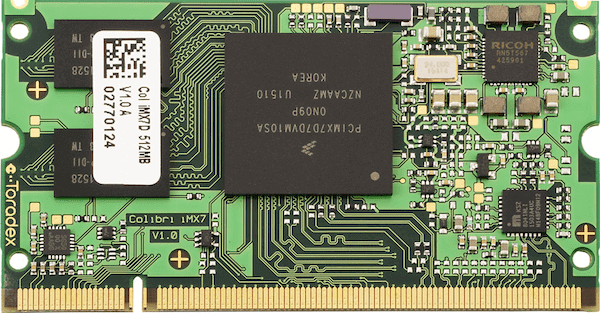NXP i.MX 7 Computer on Module - Colibri iMX7¶
Overview¶
The i.MX7 SoC is a Hybrid multi-core processor composed by Single/Dual Cortex A7 core and Single Cortex M4 core. Zephyr was ported to run on the M4 core. In a later release, it will also communicate with the A7 core (running Linux) via RPmsg.

Hardware¶
i.MX7 Single/Dual Cortex A7 (800MHz/1.0GHz) core and Single Cortex M4 (200MHz) core
Memory
RAM -> A7: 256MB, 512MB and 1GB
RAM -> M4: 3x32KB (TCML, TCMU, OCRAM_S), 1x128KB (OCRAM) and 1x256MB (DDR)
Flash -> A7: 4Gb eMMC and 512Mb NAND
Display
RGB 1920x1080x24bpp
4-wire Resistive touch
Multimedia
1x Camera Parallel Interface
1x Analog Audio Line in (Stereo)
1x Analog Audio Mic in (Mono)
1x Analog Audio Headphone out (Stereo)
Connectivity
USB 2.0 OTG (High Speed)
USB 2.0 host (High Speed)
10/100 Mbit/s Ethernet PHY
4x I2C
4x SPI
7x UART
1x IrDA
20x PWM
Up to 125 GPIO
4x Analog Input (12 Bit)
2x SDIO/SD/MMC (8 Bit)
2x CAN
For more information about the i.MX 7 SoC, Colibri iMX7 Computer on Module and Colibri Evaluation Board, see these references:
Supported Features¶
The Colibri iMX7D Computer on Module with Colibri Evaluation Board configuration supports the following hardware features on the Cortex M4 Core:
Interface |
Controller |
Driver/Component |
|---|---|---|
NVIC |
on-chip |
nested vector interrupt controller |
SYSTICK |
on-chip |
systick |
GPIO |
on-chip |
gpio |
I2C |
on-chip |
i2c |
PWM |
on-chip |
pwm |
UART |
on-chip |
serial port-polling; serial port-interrupt |
The default configuration can be found in the defconfig file:
boards/arm/colibri_imx7d_m4/colibri_imx7d_m4_defconfig
Other hardware features are not currently supported by the port.
Connections and IOs¶
The Colibri iMX7D Computer on Module with Colibri Evaluation Board was tested with the following pinmux controller configuration.
Board Name |
SoC Name |
Usage |
|---|---|---|
UART_B RXD |
UART2_TXD |
UART Console |
UART_B TXD |
UART2_RXD |
UART Console |
SODIMM_135 |
GPIO1_IO02 |
LED0 |
SODIMM_133 |
GPIO2_IO26 |
SW0 |
SODIMM_194 |
I2C4_SDA |
I2C_SDA |
SODIMM_196 |
I2C4_SCL |
I2C_SCL |
SODIMM_59 |
PWM1/GPIO1_IO08 |
PWM |
System Clock¶
The M4 Core is configured to run at a 200 MHz clock speed.
Serial Port¶
The iMX7D SoC has seven UARTs. The number 2 is configured for the console and the remaining are not used/tested.
Programming and Debugging¶
The Colibri iMX7D doesn’t have QSPI flash for the M4 and it needs to be started by the A7 core. The A7 core is responsible to load the M4 binary application into the RAM, put the M4 in reset, set the M4 Program Counter and Stack Pointer, and get the M4 out of reset. The A7 can perform these steps at bootloader level or after the Linux system has booted.
The M4 can use up to 5 different RAMs. These are the memory mapping for A7 and M4:
Region |
Cortex-A7 |
Cortex-M4 (System Bus) |
Cortex-M4 (Code Bus) |
Size |
|---|---|---|---|---|
DDR |
0x80000000-0xFFFFFFFF |
0x80000000-0xDFFFFFFF |
0x10000000-0x1FFEFFFF |
2048MB (less for M4) |
OCRAM |
0x00900000-0x0091FFFF |
0x20200000-0x2021FFFF |
0x00900000-0x0091FFFF |
128KB |
TCMU |
0x00800000-0x00807FFF |
0x20000000-0x20007FFF |
32KB |
|
TCML |
0x007F8000-0x007FFFFF |
0x1FFF8000-0x1FFFFFFF |
32KB |
|
OCRAM_S |
0x00180000-0x00187FFF |
0x20180000-0x20187FFF |
0x00000000-0x00007FFF |
32KB |
QSPI Flash |
0x08000000-0x0BFFFFFF |
64MB |
References¶
i.MX 7 Dual Reference Manual from page 190 (section 2.1.2 and 2.1.3)
At compilation time you have to choose which RAM will be used. This configuration is
done in the file boards/arm/colibri_imx7d_m4/colibri_imx7d_m4.dts with “zephyr,flash” (when CONFIG_XIP=y) and “zephyr,sram”
properties. The available configurations are:
"zephyr,flash"
- &ddr_code
- &tcml_code
- &ocram_code
- &ocram_s_code
- &ocram_pxp_code
- &ocram_epdc_code
"zephyr,sram"
- &ddr_sys
- &tcmu_sys
- &ocram_sys
- &ocram_s_sys
- &ocram_pxp_sys
- &ocram_epdc_sys
Below you will find the instructions to load and run Zephyr on M4 from A7 using u-boot.
Copy the compiled zephyr.bin to the first EXT partition of the SD card and plug into the board. Power it up and stop the u-boot execution. Set the u-boot environment variables and run the zephyr.bin from the appropriated memory configured in the Zephyr compilation:
setenv bootm4 'ext4load mmc 0:1 $m4addr $m4fw && dcache flush && bootaux $m4addr'
# TCML
setenv m4tcml 'setenv m4fw zephyr.bin; setenv m4addr 0x007F8000'
setenv bootm4tcml 'run m4tcml && run bootm4'
run bootm4tcml
# TCMU
setenv m4tcmu 'setenv m4fw zephyr.bin; setenv m4addr 0x00800000'
setenv bootm4tcmu 'run m4tcmu && run bootm4'
run bootm4tcmu
# OCRAM
setenv m4ocram 'setenv m4fw zephyr.bin; setenv m4addr 0x00900000'
setenv bootm4ocram 'run m4ocram && run bootm4'
run bootm4ocram
# OCRAM_S
setenv m4ocrams 'setenv m4fw zephyr.bin; setenv m4addr 0x00180000'
setenv bootm4ocrams 'run m4ocrams && run bootm4'
run bootm4ocrams
# DDR
setenv m4ddr 'setenv m4fw zephyr.bin; setenv m4addr 0x80000000'
setenv bootm4ddr 'run m4ddr && run bootm4'
run bootm4ddr
Debugging¶
Download and install J-Link Tools and NXP iMX7D Connect CortexM4.JLinkScript.
To run Zephyr Binary using J-Link create the following script in order to get the Program Counter and Stack Pointer from zephyr.bin.
get-pc-sp.sh:
#!/bin/sh
firmware=$1
pc=$(od -An -N 8 -t x4 $firmware | awk '{print $2;}')
sp=$(od -An -N 8 -t x4 $firmware | awk '{print $1;}')
echo pc=$pc
echo sp=$sp
Get the SP and PC from firmware binary: ./get-pc-sp.sh zephyr.bin
pc=00900f01
sp=00905020
Plug in the J-Link into the board and PC and run the J-Link command line tool:
/usr/bin/JLinkExe -device Cortex-M4 -if JTAG -speed 4000 -autoconnect 1 -jtagconf -1,-1 -jlinkscriptfile iMX7D_Connect_CortexM4.JLinkScript
The following steps are necessary to run the zephyr.bin: 1. Put the M4 core in reset 2. Load the binary in the appropriate addr (TMCL, TCMU, OCRAM, OCRAM_S or DDR) 3. Set PC (Program Counter) 4. Set SP (Stack Pointer) 5. Get the M4 core out of reset
Issue the following commands inside J-Link commander:
w4 0x3039000C 0xAC
loadfile zephyr.bin,0x00900000
w4 0x00180000 00900f01
w4 0x00180004 00905020
w4 0x3039000C 0xAA
With these mechanisms, applications for the colibri_imx7d_m4 board
configuration can be built and debugged in the usual way (see
Building an Application and Run an Application for more details).